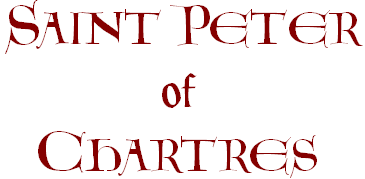

| Eventually there will be links to other pages devoted to the history of the Benedictine abbey of St. Peter (later called "Saint-Père-en-Vallee") of Chartres, situated near the river Eure, down the hill South of the Cathedral, originally situated outside the walls of the town. |
| (The following summary history is taken from Yves Delaporte's
learned article
"Chartres" in the Dictionnaire d'histoire et geographie ecclesiastique, XII (1953), col. 559) |
| Though the legend of its foundation by Clovis must be rejected, there seems to be no doubt that the abbey was in existance from at least the middle of the seventh century. |
| Invaded by an armed force and pilaged by the soldier-Bishop
Elias (840-46), it was restored by Bishop Gislebert around 860.
Destroyed by the Norsemen in 911, it was rebuilt again by Bishop Aganon, who installed secular clerics there around 930. Bishop Ragenfred sent their superior, Alveus, to Fleury (St-Benoît-sur- Loire) to be initiated into the monastic life. Alveus returned in 954 with a group of Benedictine monks and, from that time until the Revolution the house was in Benedictine hands. |
| The abbey seems to have particularly flourished in
the 12th century, when the monks corresponded with St. Bernard, enlarged
their library,
and engaged in a building campaign which resulted in the reconstruction
of most of the choir, with several chapels, in the transitional "early gothic"
style. during the course of the construction the tomb of St. Gilduin was discovered and became a place of pilgrimage. |
| The wars of the end of the middle ages and of the
16th century impoverished the abbey, and the imposition of commendatory
abbots hastened their decline.
But in 1650 it was given to the Congregation of St. Maur (a powerful movement of reform within the Benedictine community, operating from St. Germain-des-Pres in Paris) and there was a brief period of renewed prosperity. However, in 1790 there were only eight monks left at St. Peter's. Today a parish church dedicated to Saint Peter, the building dates from the eleventh (in part perhaps from the tenth) to the thirteenth centuries. The conventual buildings which one sees today (now a high school) were rebuilt around 1700 by the Maurists. |


